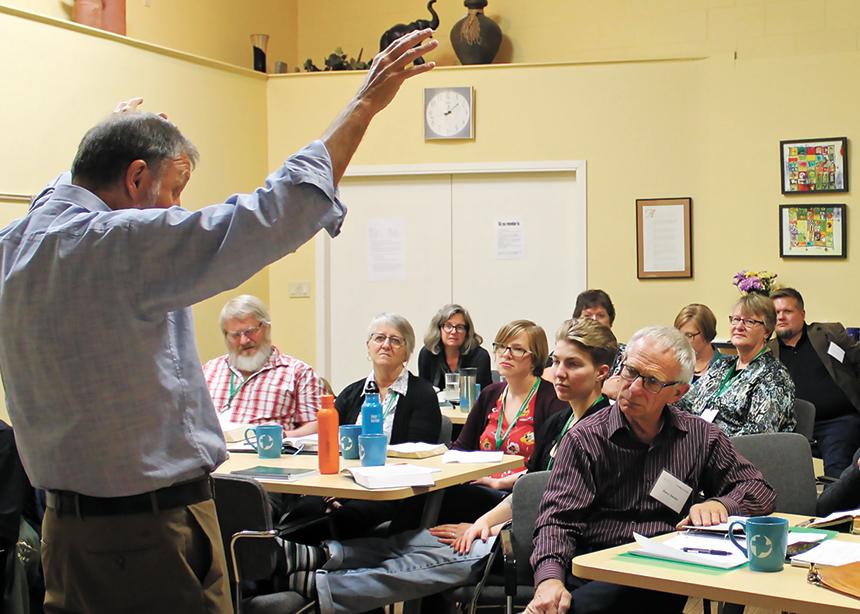Tom Yoder Neufeld likens God’s work with the church to an artist who creates a beautiful work of art out of things others have thrown away.
The professor emeritus of religious studies at Conrad Grebel University College in Waterloo, Ont., spoke at Mennonite Church Saskatchewan’s recent continuing education event.
Upwards of 26 pastors and other participants gathered at the Mennonite Central Committee Saskatchewan offices in Saskatoon for two days of learning with Yoder Neufeld. Held on Oct. 17 and 18, the event took as its theme the regional church’s focus for 2019: “Deepening our walk with each other.”
“We haven’t attended deeply to what it means to be a member of the church,” Yoder Neufeld said. “You’re part of a recycling project, thrown together with people you can’t stand, by God’s design.”
In Ephesians 2, Paul speaks of how God brought Jews and gentiles together in one body. “We are God’s masterpiece,” said Yoder Neufeld. “God is conceptualizing out of this alienated humanity a work of art, created to do good works.”
As members of one body, believers are called to walk in unity. Pointing to Ephesians 4, he said, “Unity is not our goal. We are already united in Christ.” Rather, he asked, “What does it mean to make every effort to walk in unity?”
Yoder Neufeld likened walking in unity to prisoners chained together. Walking this way “chafes, hurts, pulls and yanks,” he said, “and it requires every bit of bearing each other and caring for each other.”
Members care for each other as they “take off the old human and put on the new human,” said Yoder Neufeld. Citing Colossians 3, he noted that the new human dons new behaviours—humility, gentleness, patience and forbearance—with love worn over all of these like an overcoat. In adopting these behaviours, the new human is imitating Christ.
Philippians 2 likewise encourages readers to imitate Christ by emptying themselves as Christ did. “We’re not going to get anywhere near deepening our walk with each other until we get that dynamic,” he said.
“If we’re going to walk together deeply, [we’re] going to have to come to terms with being vulnerable,” Yoder Neufeld said. “If I think of you as better than myself . . . it includes the vulnerability that I may be wrong and the possibility of my own change.”
Truth is another significant aspect of walking together in Christ. In Ephesians 4:15, there is a phrase that is translated into English as “speaking the truth in love.” Yoder Neufeld said, “We don’t have an English verb for truth,” adding that a better rendering might be “truthing in love.” Speaking the truth has to do with words, but “truthing” has to do with character and relationships.
In addition to Paul’s writings, Yoder Neufeld also explored with participants Jesus’ teachings in Matthew 18. Like the Sermon on the Mount, he said, this chapter is a compilation of Jesus’ teachings. But the well-known verses 15 to 20 on church discipline seem stylistically out of place.
The chapter begins with the disciples asking Jesus who is greatest in the kingdom of heaven. Jesus places a child in front of them and tells them they need to become like that child if they want to enter the kingdom.
Then, in verses 6 to 9, Jesus warns of the danger of leading “one of these little ones” astray. Yoder Neufeld suggested that “little ones” refers not only to children, but to anyone who is “vulnerable in the community.”
This teaching is followed in verses 10 to 14 by the parable of the lost sheep. While the lost sheep is usually thought of as one of the little ones described in the preceding verses, Yoder Neufeld said, “Don’t identify too quickly who the lost sheep is.” He asked, “Is it possible that the abuser is the lost sheep? What would it mean for Jesus to go after that one?”
Verses 15 to 20 outline a procedure for dealing with someone who sins, but Matthew places it right after the parable of the lost sheep. Taken in this context, Yoder Neufeld said, “These verses then become a means of retrieval.” Holding a sinner accountable is a way of showing love, he added. The end goal is to win the sinner back.
Finally, in verses 21 to 22, in response to Peter’s question about how many times he should forgive, Jesus replies that forgiveness should be limitless. “How often do we have to forgive?” asked Yoder Neufeld. “Every time someone offends.”




Add new comment
Canadian Mennonite invites comments and encourages constructive discussion about our content. Actual full names (first and last) are required. Comments are moderated and may be edited. They will not appear online until approved and will be posted during business hours. Some comments may be reproduced in print.